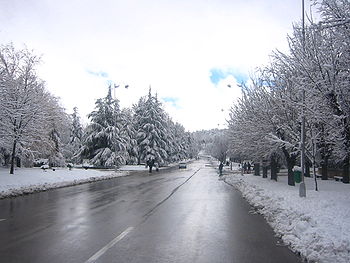 Ifrane (Amazigh: Ifran) (nicknamed Little Switzerland) is a town and ski resort in the Middle Atlas region of Morocco (population 12,000 in 2004 census). Ifrane is 1,650 m in altitude and is part of the Meknès-Tafilalet region. In Tamazight, the regional Berber language, "ifran" means caves. Background
Ifrane (Amazigh: Ifran) (nicknamed Little Switzerland) is a town and ski resort in the Middle Atlas region of Morocco (population 12,000 in 2004 census). Ifrane is 1,650 m in altitude and is part of the Meknès-Tafilalet region. In Tamazight, the regional Berber language, "ifran" means caves. BackgroundDeveloped by the French during the protectorate era for their administration due to its Alpine climate, this Morrocan town has a remarkable European style, as if it were an Alpine village. Because of its elevation, the town experiences snow during the winter months and a cool climate during the summer. Ifrane is also the place where the lowest temperature was ever recorded in Africa, -23 ºC in 1935. Animals to be found there include the barbary monkey. Among the tree species are the native Atlas cedar, Scrub oak and the introduced London plane.
The first permanent settlement of the area dates to the 16th century, when a saintly sharîf by the name of Sîdî 'Abd al-Salâm established his community in the Tizguit valley, seven km downstream from the present town. By the mid-17th century the zâwiyah was well enough established to receive an extensive iqtâ' (land grant) from the 'Alâwî sultan Mûlây Rashîd b. Muhammad. While the founder's lineage was ethnically Arab, the inhabitants of the village today mostly speak Tamazight.
Modern days
The modern town of Ifrane was established by the French administration in 1929 on land expropriated from the inhabitants of the zâwiya. The town was to be a "hill station," a cool place for colonial families to spend the hot summer months, and it was initially planned according to the "garden city" model of urban design then in vogue. The plan called for chalet-type summer homes in the Alpine style, laid out among gardens and curving tree-lined streets. A Royal Palace was also built for Sultan Muhammad b. Yûsuf. The town's first public buildings consisted of a post office and a church. Moreover, a penitentiary was built which served as a POW camp during WWII.
As elsewhere in Morocco, a shantytown called Timdiqîn soon grew up next to the colonial establishment. It housed the Moroccan population (maids, gardeners, etc.) that serviced the French vacationers. Timdiqîn was separated from the colonial garden city by a deep ravine. After independence the French properties in the original garden city were slowly bought up by Moroccans. The town was enlarged and endowed with a mosque, a municipal market and public housing estates. Furthermore, the shanty neighborhood of Timdiqîn was rebuilt with proper civic amenities.
In 1979 Ifrane became the seat of the administrative province of the same name and some government services were established. In 1995 Al Akhawayn University, an English-language, American-curriculum private university opened and this has helped re-launch Ifrane as a desirable destination for domestic tourism. Consequently, Ifrane continues to develop as both a summer and winter resort. Old chalets in the center of town are being knocked down and replaced with condominium complexes, while vacation centers and gated housing estates are springing up on its outskirts